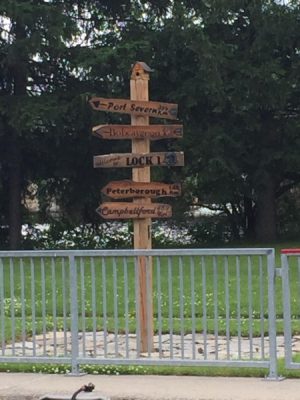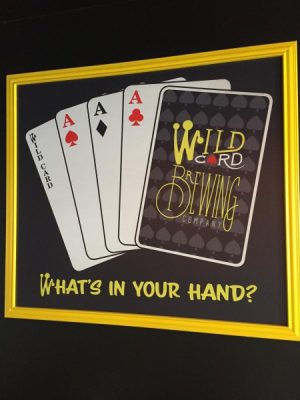6/28/18 Thursday- When you park yourself in one spot for a week, there isn’t any rush to go out and see everything. But we did get the bikes down for a little tour about town. We’ve been watching more and more looper boats come in, and have visited with a few of them. Scotty down in engineering was talking with Bru from Coconuts about a diesel additive to help keep the injectors clean and maybe even help with smoking. We’ve been trying to convince Island Girl to give up smoking, but she just can’t kick the habit. So mechanic Kenny found a diesel shop here in town that carries Stanadyne, a diesel fuel additive. That was motivation for him to get on a bike. The shop is located near the first lock on the Trent-Severn Waterway (TSW), so we figured we’d wheel on in there too, and buy our lockage pass. A one-way pass through the waterway is $4.65 per foot (length of boat). It would be about a 2 mile bike ride each way, and it was still a little cloudy out. It was supposed to get a little toasty today, so it would be good to get this done before it got too hot.
At the lock, there was a fun wooden sign for distances. It is 388 kilometers (241 miles) to Port Severn – the other end of the TSW.

There was a small boat going down through the lock, so we got to watch the operation. This is SOOO different than the Erie Canal. There, we motored the boat into the lock chamber, we each grabbed a rope that was hanging down the wall, and the lockmaster operated the closing of the gates from his little gate house. It was pretty much a do-it-yourself kind of deal. But here in the TSW, nearly all of the locks have a rubber coated cable attached to the wall about every 15 feet. They are similar to the cables and pipes on the Erie, where you place a line from the boat around the cable, and the bitter end goes back to the boat to be cleated off, or held. There are 3-4 lock operator/assistants, who will take your line and run it around the cable for you, they will help keep your boat off the wall, they will answer questions about where the best local restaurant is – they are so nice! It is often college kids that work the locks in the summer. And then – look closely. The young man is pushing that V-shaped pipe around in a circle (like a merry-go-round), which is manually closing the lock doors! We got all kinds of maps and information about the TSW, and talked with Ian, the lockmaster here. We found out that he will be speaking at our Looper event tomorrow. Cool!

We stopped at the diesel shop and got three gallons (six half-gallon jugs) of additive stuff. Four went into Captain’s backpack, two into mine. Back on the bikes. HEY! There’s a brewery sign! We went and checked it out – it was after noon, after all! Wild Card Brewing had 8 beers on tap. They could not serve anything that they did not produce on site. So Captain tried a brewski and I had ice water. Back on the bikes, and back to the boat.

Here is our nice marina. It really is a nice facility. I think they need bocce ball or croquet out here on the huge lawn!

They have a cute little help-yourself herb garden!

And yes, there are a lot of looper flags flying! All of these trawlers are on the end of our dock, all docked with the bow in. Among them are Greek’s Folly and Short Vacation that we met a few days ago.

I got restless after a little while, so I went for a walk over to the Metro grocery store, and a little walkabout around the area nearby. I saw a church steeple, so had to go check it out. This is St Peter’s Catholic Church. The sign above the statue says “St Peter in Chains Erected 1884”. St. Peter’s parish is older than Canada itself, and the present church building was built just seven years after Confederation in 1874.


That piece of trivia made me wonder about how Canada became a country – after all, July 1 is Canada Day! Here is what I found: Britain and France were the European players in North America. After a seven year war ended in 1763, France surrendered its land in North America to Britain. From this time on Britain had control of most of North America. At the time of the war with France most of Britain’s colonies in North America were in what is now the United States. However, these thirteen colonies were angry at the way Britain had been treating them, so in 1775 they began a war with Britain for their independence. The Americans won the war and the British were forced to recognize the United States as its own country. Because of the war, Britain lost much of its land, and had a bad relationship with the United States. (Right?!) The land left over was called British North America. This would eventually become known as Canada almost 100 years later. In 1840, the colonies of Upper and Lower Canada were joined to form the Province of Canada. Upper Canada was mostly English speaking, while Lower Canada was mostly French speaking. In the 1860s there were many British colonies in what is now Canada: British Columbia, Newfoundland, Nova Scotia, New Brunswick, Prince Edward Island and the Province of Canada. Since America had fought Britain to gain its independence, the relationship between British North America and the United States had never been stable. The relationship became even worse when Britain supported the U.S. South in the American Civil War (hoping to reclaim the south.). The North U.S. won the war and was angry at Britain for helping the South. Many Americans wanted to take over all of what is now Canada. Meanwhile, Britain didn’t want to have to pay for the cost of defending its colonies. It decided to encourage the colonies to join together, because the United States would be less likely to attack Canada if it were a self-governing country rather than separate colonies of Britain. The fear of the United States helped to strengthen the call for Confederation. On July 1, 1867, Canada became a country with four provinces: New Brunswick, Nova Scotia, and the Province of Canada was split: Upper Canada became the province of Ontario, and Lower Canada became the province of Quebec. It would take more than a century to add the other six provinces and three territories that make up Canada today. [Library and Archives, Canada] So there you have it – a mini history lesson on Canada! It will be celebrating 151 years in just a couple of days.
Here are some pictures of some other historic buildings that I found. I could not find any information on this one.

This one surprised me. It is House of the Commandments Islam. I knew there was no way it had always been an Islamic Worship Center. It was originally the King Street United Church, established in 1876, but the building was sold in 2015 when three United Churches combined into one at a different location.

Nearby was this cool building. It looked like it was a house, but I don’t know what it is.

Then the old Trenton City Hall and Market – it kind of looked like a colonial America building. It was built in 1861.

I did manage to make it to Metro, which is a really nice grocery store! When I was looking in the fridge for what to fix for dinner tonight, I noticed that I have a tube of Pillsbury country biscuits. I kind of mumbled out loud ‘what should I do with these?’ A mysterious voice answered hauntingly “biscuits and gravy”… Hmm – that would make the captain really happy. So while I was at the store, I searched high and low for a country gravy mix like we get a home. No way. The only kind of gravy around here is brown gravy, and poutine gravy. (I’ll explain that later.). No biscuits and gravy tomorrow, captain! And then, I was surprised at the form that some items are sold in. Milk was packaged in plastic bags rather than boxes or jugs. How do you pour out of a bag!? And cheese is in slabs rather than blocks. How do you slice that for a sandwich?! We’re going grocery shopping with a car this weekend, so maybe we’ll check another store. I only bought some things for dinner tonight: a steak for the BBQ, some sweet corn (wowzer it was good!), and ice cream for dessert. We enjoyed another dinner on the back patio at sunset – delicious and delightful!
Given my fondness for things, places and events of historical interest, I appreciate your frequent mini-history essays. Keep it up.
Curious why you chose to navigate the Trent-Severn Waterway versus staying on the Lake. More scenic? weather? marinas? By the way, here in Seattle is sweater-weather; East coast sweltering. Are you affected? Thanks.
Thanks Ned! Yes, the TSW will be very scenic, and it takes us into Georgian Bay, and then we’ll travel up and through the North Channel. Loopers who do this route say it is the most beautiful area of the whole trip. We are HOT right now in Ontario. Highs at 90 degrees for the next 5 days, then mid 80’s for the foreseeable future! ☀️
When we did the loop in 2012/13, the coldest day was in Marathon, FL and the hottest day was in Canada!
Your lesson on Canada history couldn’t have come at a better time. I took a on line sample test on Canadian history for moving to Canada. I failed pretty bad. Surprised me for as much time I have spent up there and have so many friends. I guess I had better pay more attention when it is Rum:30.